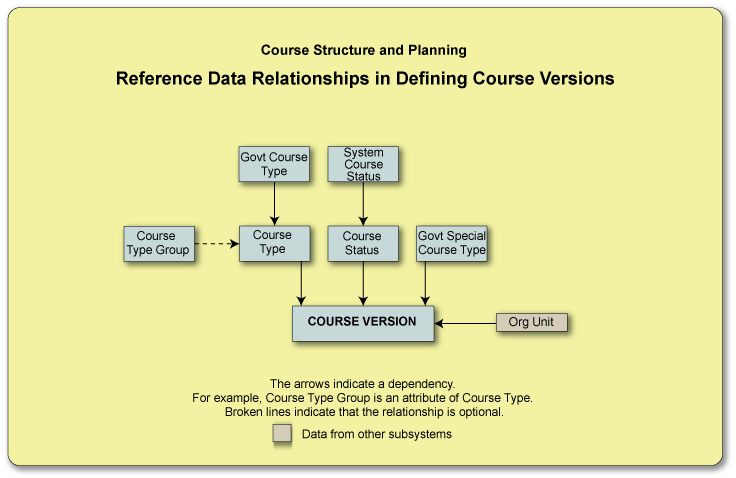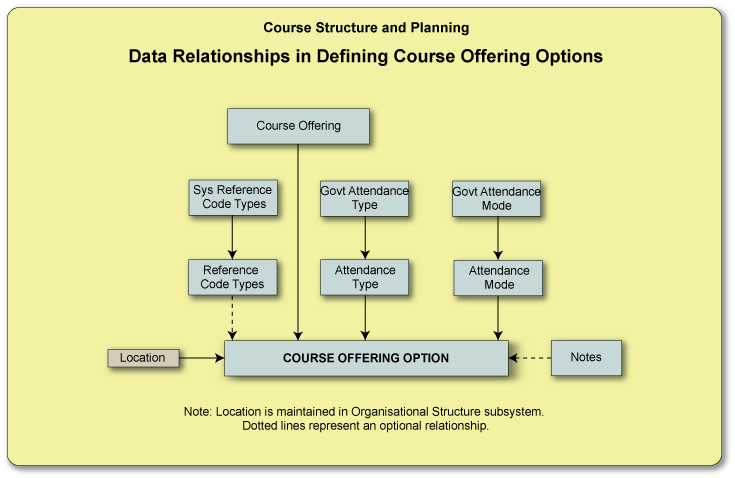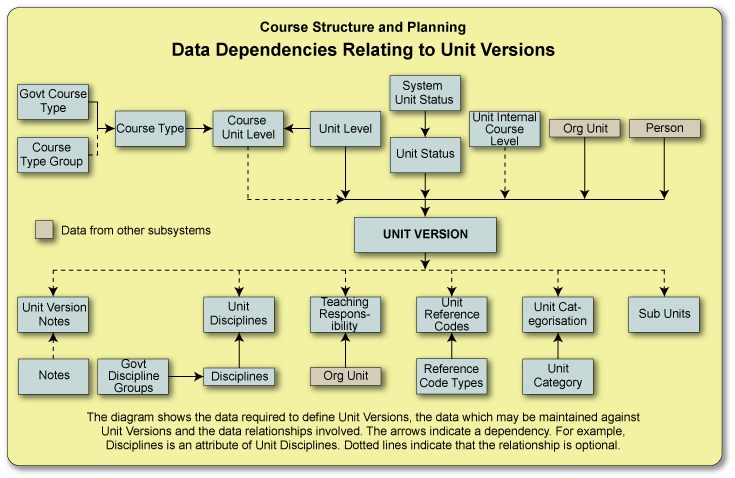
| Top of CRS | Index | Table of Contents | Feedback |  |
Understanding Course Structure and Planning
The Course Structure and Planning Subsystem maintains all of the details required to fully define courses and units. Students enrol in Course Offering Options and Unit Offering Options which are defined by many attributes. The following diagrams and explanations describe the relationships between data elements, and in particular, how they combine to create Course and Unit Offering Options. The first diagram shows the broad relationships between the main data groups within the Subsystem.
Further information is available in the Subsystem Glossary section and in the sections devoted to individual forms.
For information about Course Plan Structure Versions, see Course Plan Structure Overview.
Diagrams are provided to describe:
Other topics include:
Refer also to:
Relationships Between Main Data Groups. (crs01)

This diagram illustrates the types of data recorded in the Subsystem which ultimately permit the specification of the Course and Unit Offering Instances into which students are enrolled.Reference details are the basic data used to define courses and units. For example, a Course Status is required for the definition of a course. The permissible set of Course Statuses is maintained separately as reference data. These details remain relatively static over time. Individual course and unit details are defined by their combinations of attributes, including those defined as reference details. The main data groups shown in this diagram are expanded upon below.
Definition of Course Versions. (crs02)

This shows how reference detail data is combined to define Course Versions. In these diagrams, solid arrows indicate that the data is mandatory while dotted arrows indicate an optional relationship. Thus, to define a Course Version, it is mandatory to define a Course Type, Course Status, Government Special Course Type and Organisational Unit for the Course Version. Similarly, a Course Status must have a System Course Status assigned to it to be fully defined. A Course Type must be assigned a Government Course Type but the assignment of a Course Type Group is optional.

This diagram illustrates the detail which may be maintained against each Course Version once it has been defined. The diagram also shows that many of the attributes of a Course Version are defined by other data which is maintained as reference data. For example, a Course Version can be assigned a particular Field of Study (making it the CRS Field of Study). This Field of Study must be maintained as reference data and is, in turn, dependant on the existence of a suitable Government Field of Study for its own definition.
Relationship Between a Course Version and its Offerings, Offering Instances, Offering Options and Offering Patterns. (crs04)

The diagram above represents the relationship between Course Versions and their Offerings, Offering Options and Offering Patterns. Typical data is included to show how a particular set of records is 'built up'. Students actually enrol in a particular Course Offering Pattern of a course. A unique Course Offering Pattern is created by combining information relating to a specific Course Version with information describing when (Calendar), where (Location) and how (Attendance Type and Mode) the course will be offered.
Course Offering Option Data Relationships. (crs05)

Not all reference data is applied directly to Course Versions. Course Offering Options are also 'built' from a number of data elements. This diagram shows the relationships required to define a Course Offering Option.
Definition of Unit Versions. (crs06)

The main Unit Data Groups shown in the first diagram are expanded upon here. The data elements above the Unit Version in the diagram are reference details used in the definition of a Unit Version. Unit Status and Course Unit Level are both dependant on other reference data for their definition.
The data elements below the Unit Version are the details that may be maintained against each Unit Version once it has been defined. The diagram also shows that many of the attributes of a Unit Version are defined by other data that is maintained as reference data. For example, a Unit Version can be assigned a particular discipline (making it the Unit Discipline). This discipline must be maintained as reference data and is, in turn, defined by a suitable Government Discipline Group.
Unit Offering Relationships (crs07)

This diagram shows the relationships required to uniquely define a Unit Offering Option. Students enrol in Unit Offering Options. Typical data values are included in the diagram to show how the data is combined.
Notes Facility in Course Structure and Planning. (crs08)

This illustrates the data relationships relating to the Notes Facility, within Course Structure and Planning. The notes function allows additional information to be attached to certain data. The Note Type attribute enables notes to be grouped according to a common characteristic. Notes of many types may be created, each type reflecting the purpose of the notes associated with it. In the Course Structure & Planning Subsystem for example, notes of type HANDBOOK could be created to facilitate maintenance of the University handbook.
Notes may be created, stored and retrieved in almost any format. The currently available formats are:
Full instructions and explanations for the use of the notes facility are covered under Notes Facility in the General System Functions and Facilities section.
Note:
Unit Sets are used to define a path of study undertaken to ensure the satisfactory progression and completion of Student Course Attempts.
The Unit Set concept features in the following areas of Callista:
Academic/Administrative Unit Sets
Unit Sets can be differentiated as Academic or Administrative.
Academic Unit Sets are those that further define the path of study a student has selected. For example: a MAJOR in Accounting or a SPECIALISATION in Taxation.
Administrative Unit Sets can be used to restrict the set of pathways a student can follow within a course. For example, a Bachelor of Business that has two STREAMS
Through the use of Unit Sets, a student enrolled in a Bachelor of Business may nominate to complete an Accounting MAJOR, this student would be restricted to Unit Sets related to STREAM1. They may not pursue Unit Sets in STREAM2 except in special circumstances.
Administrative Unit Sets may also include subjects that all students are required to complete. For example: a CORE Unit Set which comprises an English unit and a Physical Education unit may have to be completed by all students as part of their course regardless of field.
The use of Administrative Unit Sets can also be used to define progression components of a course. By default, Administrative Unit Sets are not displayed on documentation such as Transcripts and Testamurs.
Examples of the Use of Unit Sets
Bachelor of Business - M320
| CORE (all students must complete)(Administrative) |
|||||
Stream1(Administrative) |
Stream2(Administrative) |
||||
| Majors |
Majors |
||||
| Accountancy |
Banking and Finance |
Economics |
Management |
Marketing |
Communications |
| Minors |
Minors |
||||
| Taxation |
Share Market |
Third World Countries |
Industrial Relations |
Advertising |
Public Relations |
| Small Business |
International Business |
Public Sector Economics |
Public Sector Management |
Tourism |
Organisational Communication |
| Information Systems |
Banking Regulations |
Regional Planning |
Human Resource Management |
Arts and Culture |
Languages |
| Auditing |
Money Management |
Arbitration |
Sports |
||
| Specialisations |
|||||
| Public Speaking |
|||||
| Information Technology |
|||||
| Budgets |
|||||
| Proposals and Grants |
|||||
| Government and Politics |
|||||
Students attempting a Bachelor of Business are required to complete:
Possible Rules of the Bachelor of Business:
For example, a student enrolled in a Bachelor of Business and having selected to do Accountancy would have the following Unit Set options:
Unit Set MAJORS or MINORS within STREAM2 can be selected by the student in special circumstances, as institution policy dictates. These circumstances could require the use of the Authorised By fields.
The CORE Unit Set is a policy of the institution that requires all students to complete an English, Mathematics and Physical Education unit within their first year of study.
The CORE, STREAM1 and STREAM2 Unit Sets are Administrative, details of the Unit Set do not appear on transcripts and testamurs.
Unit Sets Reference Data
In order for Unit Sets to be created, the following reference data must be created and maintained:
| Reference Data |
Purpose |
Maintenance Form |
|
|
Used to define the type of Unit Set in CRSF4200. Each Unit Set category must be assigned a rank. |
|
|
|
Used to define the status of a Unit Set in CRSF4200. It is recommended that one to one mapping be established with the Callista system values of ACTIVE, INACTIVE and PLANNED. |
Setting Up and Maintaining Unit Sets
There are two mechanisms for creating and maintaining Unit Sets.
First:
Then either:
Or, when establishing courses:
Unit Sets can be attached to entry point reference code in the Maintain Course Entry Point Reference Codes form (CRSF1420). By mapping to entry point codes, applicants uploaded into Admissions through the use of the Process TAC Offer File Load job (ADMJ4200) are automatically admitted to the Unit Set which then becomes part of their Admission Offer.
Attaching Unit Sets to Student Course Attempts
When a student enrols in a Course Attempt, Unit Sets can be selected for the Course Attempt to further define the students intended path of study.
To attach Unit Sets to a Student Course Attempt:
Encumbrances
One of the System encumbrance effect types available to institutions is 'Excluded from Enrolment in a Specific Course Unit Set'. This effect can be used to prevent a student within a particular course from selecting a specific Unit Set. Refer to the Maintain Basic Person Encumbrance Details form (ENRF6310) for further details on applying encumbrances to individual students.
Callista provides a number of mechanisms by which existing course and unit information can be used to create new information, considerably reducing the work involved in maintaining curriculum and associated data. These include:
These functions are described in Course and Unit Rollover Processes.
Last modified on 3 July, 2009 2:52 PM
History Information
| Release Version | Project | Change to Document |
| 11.1 | 1447 - Course Plans | Added link to the Course Plan Structures Overview page. |